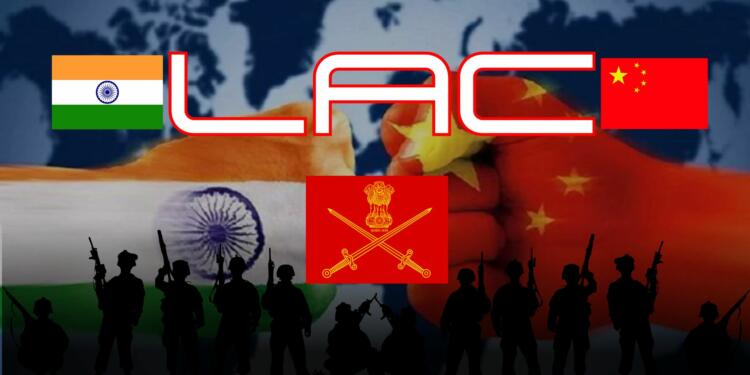In the complex geopolitical landscape of the India-China border, tensions have escalated in recent years, particularly along the Line of Actual Control (LAC). Historical disputes and sporadic confrontations have underscored the need for robust defensive capabilities, especially in critical sectors like Ladakh and the central sector. India’s decision to convert the Uttar Bharat (UB) Area into a corps headquarters signals a strategic shift aimed at enhancing readiness and coordination along the LAC. This move, coupled with progressive combatisation efforts, reflects India’s proactive approach to addressing evolving security challenges and safeguarding its territorial integrity amidst escalating tensions with China.
Background
The Line of Actual Control (LAC) delineates the de facto boundary between India and China, stretching over 3,488 kilometers across varying terrain. Unlike a formal border, the LAC is not clearly demarcated, leading to occasional disputes and tensions between the two nuclear-armed neighbors. India-China relations have been marked by historical territorial disputes, including the unresolved border issue, which has led to periodic military standoffs and diplomatic tensions.
Recent years have witnessed escalating military standoffs and tensions between India and China, notably in the Ladakh region. The Galwan Valley clash in June 2020, which resulted in casualties on both sides, marked one of the most serious confrontations between the two countries in decades. Subsequent skirmishes and incursions along the LAC have further strained bilateral relations and heightened security concerns.
Given the precarious nature of the border situation, there is an urgent need for India to strengthen its defensive capabilities along the LAC, particularly in critical sectors such as Ladakh and the central sector. Enhancing military readiness and infrastructure in these areas is essential to deter aggression and effectively respond to any provocations from China.
Key Developments
Conversion of Uttar Bharat (UB) Area into a Corps Headquarters
The decision to convert the UB Area into a corps headquarters with war-fighting functions represents a significant strategic shift in India’s defense posture along the LAC. This move underscores the Indian Army’s commitment to bolstering its capabilities and preparedness in the central sector, which has historically been relatively less disputed compared to other areas along the LAC.
Insights from Military Experts
Military experts like Lieutenant General DS Hooda (retd.) have emphasized the significance of converting the UB Area into a corps headquarters. They argue that this restructuring will enhance operational efficiency and readiness, enabling better coordination and response to potential threats along the LAC. Hooda’s insights highlight the strategic rationale behind the decision and its implications for India’s defense strategy in the region.
Progressive Combatisation of UB Area
Over the past few years, there has been a concerted effort to enhance the operational readiness of the UB Area through progressive combatisation. This process involves reorganizing administrative formations into combat-ready units capable of rapid deployment and effective action in case of contingencies. The transformation of the UB Area reflects India’s proactive approach to strengthening its defensive posture along the LAC and adapting to evolving security challenges.
These key developments underscore India’s strategic imperative to bolster its defense capabilities along the LAC, particularly in critical sectors like the central sector. The conversion of the UB Area into a corps headquarters signifies a proactive measure aimed at enhancing India’s readiness to address emerging threats and safeguard its territorial integrity in the face of escalating tensions with China.
Operational Changes
The transformation of the Uttar Bharat (UB) Area into a corps headquarters signifies significant operational changes aimed at enhancing India’s defensive capabilities along the central sector of the Line of Actual Control (LAC).
Accommodation of Additional Troops and Combat Responsibilities
The conversion of the UB Area into a corps headquarters involves restructuring its operational structure to accommodate additional troops and combat responsibilities. This includes deploying more forces and resources to effectively patrol and defend the central sector of the LAC, thereby strengthening India’s defensive posture in the region.
Integration of Independent Brigades and Divisions
Independent brigades and divisions operating within the UB Area are being integrated under the new corps headquarters. This consolidation allows for better coordination and command structure, enabling more efficient deployment and utilization of military assets in response to potential threats along the LAC.
Implications for Enhancing Defensive Capabilities
These operational changes have significant implications for enhancing India’s defensive capabilities along the central sector of the LAC. By establishing a dedicated corps headquarters with war-fighting functions, India aims to improve its readiness to respond effectively to any escalation or incursion by Chinese forces in the region. This reorganization reflects a proactive approach to address evolving security challenges and reinforces India’s commitment to safeguarding its territorial integrity.
Strategic Implications
The central sector of the LAC holds strategic importance in India-China border dynamics for several reasons.
Geopolitical Significance
The central sector serves as a crucial gateway between India’s heartland and the Tibetan plateau. Control over this area is essential for both countries in terms of territorial integrity and strategic influence.
Less Disputed Terrain
Unlike other sectors of the LAC, the central sector has historically seen fewer border disputes between India and China. However, recent developments, including infrastructure build-up and increased military presence, have heightened tensions in this region.
Reorientation of Focus
The Indian Army’s decision to strengthen its posture in the central sector reflects a reorientation of focus to address emerging security challenges. This shift underscores the evolving nature of the border dynamics and the need for India to adapt its defense strategy accordingly.
Impact on Deterrence Posture
The establishment of a dedicated corps headquarters and the integration of independent brigades and divisions enhance India’s deterrence posture along the LAC. It sends a clear signal to China that India is prepared to defend its territorial interests and respond effectively to any provocation or aggression.
Diplomatic and Military Dialogue
Recent diplomatic and military talks between India and China have aimed to ease tensions along the LAC, particularly in the Ladakh sector.
Despite challenges, there have been some successes in disengagement efforts, including the withdrawal of troops from certain friction points along the LAC.
However, significant challenges remain, particularly regarding the resolution of long-standing border disputes and the establishment of mutually acceptable boundary mechanisms.
Insights from Army Chief General Manoj Pande – Army Chief General Manoj Pande has emphasized the importance of maintaining a high state of operational preparedness along the LAC while simultaneously engaging in dialogue with China to resolve outstanding issues. His insights underscore the complexity of the situation and the ongoing efforts to achieve a peaceful resolution through diplomatic and military channels
In conclusion, India’s strategic initiatives, such as converting the Uttar Bharat (UB) Area into a corps headquarters and progressive combatisation, signify a determined effort to bolster defensive capabilities along the Line of Actual Control (LAC). These measures underscore India’s commitment to enhancing readiness and coordination, particularly in critical sectors like the central region. Despite ongoing diplomatic and military dialogues aimed at easing tensions, the imperative for maintaining a high state of operational preparedness remains paramount. Through proactive measures and diplomatic engagement, India aims to assert its territorial integrity and deter potential provocations along the LAC, ensuring stability in the region.
Also Read: Zee-Sony: Still trying to save their “$10Billion” Marriage































